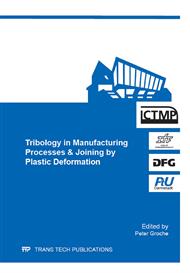[1]
Torres, H.; Horwatitsch, D.; Varga, M.; Schuster, M.; Adam, K.; Rodriguez Ripoll, M.: Hot shearing process: Correlation of numerical simulation with real wear phenomena, Tribology International, in press, 2014, http: /dx. doi. org/10. 1016/j. triboint. 2014. 01. 025.
DOI: 10.1016/j.triboint.2014.01.025
Google Scholar
[2]
Torres, H.; Varga, M.; Adam, K.; Badisch, E.: Wear phenomena in high temperature sheet shearing blades, Wear, 2013, 306, pp.10-16.
DOI: 10.1016/j.wear.2013.06.024
Google Scholar
[3]
Hambli, R.; Guerin, F.: Application of a neural network for optimum clearance prediction in sheet metal blanking processes, Finite Elements in Analysis and Design, 2003, 39, pp.1039-1052.
DOI: 10.1016/s0168-874x(02)00155-5
Google Scholar
[4]
Arrazola, P.J.; Özel, T.; Umbrello, D.; Davies, M.; Jawahir, I.S.: Recent advances in modelling of metal machining processes, CIRP Annals - Manufacturing Technology, 2013, 62, pp.695-718.
DOI: 10.1016/j.cirp.2013.05.006
Google Scholar
[5]
Kroiß, T.; Engel, U.; Merklein, M.: Comprehensive approach for process modeling and optimization in cold forging considering interactions between process, tool and press, Journal of Materials Processing Technology, 2013, 213, pp.1118-1127.
DOI: 10.1016/j.jmatprotec.2012.09.004
Google Scholar
[6]
Özel, T.: Computational modelling of 3D turning: Influence of edge micro-geometry on forces, stresses, friction and tool wear in PcBN tooling, Journal of Materials Processing Technology, 2009, 209, pp.5167-5177.
DOI: 10.1016/j.jmatprotec.2009.03.002
Google Scholar
[7]
Yen, Y. -C.; Jain, A.; Altan, T.: A finite element analysis of orthogonal machining using different tool edge geometries, Journal of Materials Processing Technology, 2004, 146, pp.72-81.
DOI: 10.1016/s0924-0136(03)00846-x
Google Scholar
[8]
Arft, M.; Klocke, F.: High performance turning of austempered ductile iron (ADI) with adapted cutting inserts, Procedia CIRP, 2013, 8, pp.129-134.
DOI: 10.1016/j.procir.2013.06.077
Google Scholar
[9]
Dogra, M.; Sharma, V.S.; Dureja, J.: Effect of tool geometry variation on finish turning – A Review, Journal of Engineering Science and Technology Review, 2011, 4, pp.1-13.
Google Scholar
[10]
Wang, X.Z.; Masood, S.H.: Investigation of die radius arc profile on wear behaviour in sheet metal processing of advanced high strength steels, Materials & Design, 2011, 32, pp.1118-1128.
DOI: 10.1016/j.matdes.2010.11.005
Google Scholar
[11]
Rech, J.; Yen, Y. -C.; Schaff, M.J.; Hamdi, H.; Altan, T.; Bouzakis, K.D.: Influence of cutting edge radius on the wear resistance of PM-HSS milling inserts, Wear, 2005, 259, pp.1168-1176.
DOI: 10.1016/j.wear.2005.02.072
Google Scholar
[12]
Winkelmann, H.; Badisch, E.; Kirchgassner, M.; Danninger, H.: Wear mechanisms at high temperatures. Part 1: wear mechanisms of different Fe-based alloys at elevated temperatures, Tribology Letters, 2009, 34, pp.155-166.
DOI: 10.1007/s11249-009-9421-y
Google Scholar
[13]
Winkelmann, H.; Varga, M.; Badisch, E.; Danninger, H.: Wear mechanisms at high temperatures: Part 2: temperature effect on wear mechanisms in the erosion test, Tribology Letters, 2009, 34, pp.167-175.
DOI: 10.1007/s11249-009-9425-7
Google Scholar
[14]
Winkelmann, H.; Badisch, E.; Varga, M.; Danninger, H.: Wear mechanisms at high temperatures. Part 3: changes of the wear mechanism in the continuous impact abrasion test with increasing testing temperature, Tribology Letters, 2010, 37, pp.419-429.
DOI: 10.1007/s11249-009-9534-3
Google Scholar
[15]
Varga, M.; Winkelmann, H.; Badisch, E.: Impact of microstructure on high temperature wear resistance, Procedia Engineering, 2011, 10, pp.1291-1296.
DOI: 10.1016/j.proeng.2011.04.215
Google Scholar
[16]
Varga, M.; Rojacz, H.; Winkelmann, H.; Mayer, H.; Badisch, E.: Wear reducing effects and temperature dependence of tribolayer formation in harsh environment, Tribology International, 2013, 65, pp.190-199.
DOI: 10.1016/j.triboint.2013.03.003
Google Scholar
[17]
So, H.; Faßmann, D.; Hoffmann, H.; Golle, R.; Schaper, M.: An investigation of the blanking process of the quenchable boron alloyed steel 22MnB5 before and after hot stamping process, Journal of Materials Processing Technology, 2012, 212, pp.437-449.
DOI: 10.1016/j.jmatprotec.2011.10.006
Google Scholar
[18]
Subramonian, S.; Altan, T.; Ciocirlan, B.; Campbell, C.: Optimum selection of variable punch-die clearance to improve tool life in blanking non-symmetric shapes, International Journal of Machine Tools and Manufacture, 2013, 75, pp.63-71.
DOI: 10.1016/j.ijmachtools.2013.09.004
Google Scholar
[19]
Chiappini, E.; Tirelli, S.; Albertelli, P.; Strano, M.; Monno, M.: On the mechanics of chip formation in Ti–6Al–4V turning with spindle speed variation, International Journal of Machine Tools and Manufacture, 2014, 77, pp.16-26.
DOI: 10.1016/j.ijmachtools.2013.10.006
Google Scholar
[20]
Bäker, M.: Finite element simulation of high-speed cutting forces, Journal of Materials Processing Technology, 2006, 176, pp.117-126.
DOI: 10.1016/j.jmatprotec.2006.02.019
Google Scholar
[21]
Arrazola, P.J.; Özel, T.: Investigations on the effects of friction modeling in finite element simulation of machining, International Journal of Mechanical Sciences, 2010, 52, pp.31-42.
DOI: 10.1016/j.ijmecsci.2009.10.001
Google Scholar
[22]
Schey, J.A.; Lohn, A.H.: Durability of graphite films in plastic deformation, Journal of Lubrication Technology, 1975, 97, pp.289-294.
DOI: 10.1115/1.3452577
Google Scholar
[23]
Petersen, S.B.; Martins, P.A.F.; Bay, N.: Friction in bulk metal forming: a general friction model vs. the law of constant friction, Journal of Materials Processing Technology, 1997, 66, pp.186-194.
DOI: 10.1016/s0924-0136(96)02518-6
Google Scholar
[24]
Cockroft, M.G.; Latham, D.J.: Ductility and the workability of metals, Journal of the Institute of Metals, 1968, 96, pp.33-39.
Google Scholar
[25]
Wang, L.; Yang, H.: Friction in aluminium extrusion—part 2: A review of friction models for aluminium extrusion, Tribology International, 2012, 56, pp.99-106.
DOI: 10.1016/j.triboint.2012.06.006
Google Scholar
[26]
Bay, N.: Friction stress and normal stress in bulk metal-forming processes, Journal of Mechanical Working Technology, 1987, 14, pp.203-223.
DOI: 10.1016/0378-3804(87)90061-1
Google Scholar
[27]
Hosseinkhani, K.; Ng, E.: Analysis of the cutting mechanics under the influence of worn tool geometry, Procedia CIRP, 2013, 8, pp.117-122.
DOI: 10.1016/j.procir.2013.06.075
Google Scholar
[28]
Varga, M.; Winkelmann, H.; Badisch, E.; Schweiger, H.; Perko, J.: Blunting resistance of different cold work tool steels: Influence of chemical composition and heat treatment procedure, Tribologie und Schmierungstechnik, 2011, 58, pp.15-18.
Google Scholar


